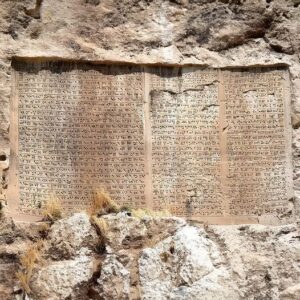Introduction to the Inscription
More than 2,400 years ago, an ancient inscription was carved into the mountainside near Van Fortress in present-day Turkey. This engraving was commissioned by Emperor Xerxes I during his reign from 486 to 465 BCE, showcasing his power and devotion to Ahura Mazda, the supreme god of the Persian Empire’s Zoroastrian faith.

The Message of the Inscription
The inscription, written in three languages—Old Persian, Elamite, and Babylonian—contains words praising Ahura Mazda: “A great god is Ahuramazda, the greatest of the gods… who made Xerxes king, one king of many, one lord of many.”
These words not only reflect Xerxes I’s reverence for Ahura Mazda but also assert his absolute authority as a “king of kings.” This declaration reinforces his status while sending a powerful message about the strength and reach of his rule over the vast territories of his empire.
Language and Culture Analysis: Three Languages for One Empire
The use of three languages on this inscription is a remarkable detail. Old Persian was the official language of the Achaemenid court, while Elamite and Babylonian were widely spoken in the empire’s western territories. This inscription is not only a proclamation but also a symbol of the cultural and religious diversity the Achaemenid Empire encompassed.
By employing multiple languages, Xerxes I not only conveyed his message of authority but also demonstrated an understanding and respect for the various cultures within his empire. This approach could be seen as a way to unify different peoples under one dynasty, creating an image of a united and inclusive empire.
The Inscription and Belief in Ahura Mazda
Ahura Mazda, the supreme deity of Zoroastrianism, was not only a figure of worship but also a symbol of integrity and power in the Achaemenid Empire. Xerxes I used Ahura Mazda’s image to legitimize his rule, presenting himself as a “god-appointed king.” This also indicates his belief that his authority was divinely given, making his reign sacred and indisputable.
The Historical Value of the Inscription
The survival of this inscription through thousands of years is a testament to the strength and endurance of ancient Persian civilization. Despite the harsh forces of nature and historical upheavals, the lines remain intact, allowing us direct access to the words of an ancient king. This is not just a historical document but a cultural treasure that helps us understand how ancient emperors consolidated power, upheld their faith, and transmitted their message.

Conclusion
Xerxes I’s inscription is not only an ancient relic but also a symbol of a great civilization and a vast empire with rich cultural values. Through this engraving, we witness not only the power of a king but also the cultural complexity and diversity of the Achaemenid Empire. It stands as a unique bridge between the past and the present, allowing us to access a vibrant piece of world history.
